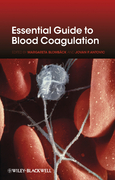
Thrombotic and bleeding disorders affect at least 10 million people in the USalone. There has also been a great deal of concern over travel-related deep vein thrombosis and therefore much more interest and research into the field ofblood clotting. This new and concise practical guide will cover all the essentials one needs to know when managing thrombotic and bleeding disorders. The field of haematology is undergoing major advances in thrombosis research, including significant additions to recommended treatment protocols. The Essential Guide to Coagulation will distil the most clinically, up-to-date and relevant material from the literature for all those working in the field. Faced with a bleeding patient, it may be difficult to discern whether blood loss is due to alocal factor or secondary to an underlying haemostatic defect. There are a range of simple and specialized laboratory texts which can be performed to further define the cause of bleeding in a patient. The first edition of this book was published in Swedish only by the Karolinska Institute and supported by a bulk sale from NovoNordisk. Since its publication, there have been many developments in the field. This includes a pipeline of many new anticoagulant drugs, including Ximelagatran, an oral anticoagulant being developed by AstraZeneca asExanta. These new classes of ‘direct thrombin inhibitors’ slow the coagulation cascade by directly binding to thrombin, a clotting factor essential in the clotting process. If thrombin is blocked, clot formation is delayed. A key component of this guide will be the latest treatment strategies available for patients.
- ISBN: 978-1-4051-9627-7
- Editorial: Wiley-Blackwell
- Encuadernacion: Rústica
- Páginas: 192
- Fecha Publicación: 29/12/2009
- Nº Volúmenes: 1
- Idioma: Inglés
